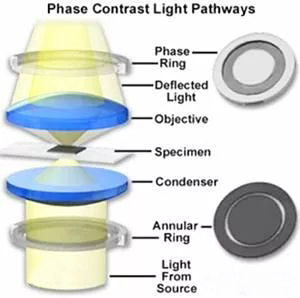
Due to objective conditions, no optical system can produce a theoretically ideal image. The existence of various phase differences affects the imaging quality of convex lens in microscope. Here take you to understand to the factors affecting microscope imaging. The following is a brief introduction to each phase difference.

1. Chromatic Aberration
Chromatic aberration is a serious defect of lens imaging of convex lens in microscope. It occurs when polychromatic light is the light source. And monochromatic light does not produce chromatic aberration. White light composees of seven kinds of red, orange, yellow, green, blue, blue and purple. And the wavelengths of various lights are different, so the refractive index when passing through the microscope lens is also different. So that a spot on the object side may form a color spot on the image side.
The chromatic aberration generally has position chromatic aberration and magnification chromatic aberration. The positional chromatic aberration makes the image observed at any position, with color spots or halos, which makes the image blurry. The chromatic aberration of magnification causes the image to have colored edges.
2. Spherical Aberration
Spherical aberration is the monochromatic phase difference of points on the axis. And it is because of the spherical surface of the optical lens and convex lens in microscope.The result of spherical aberration is as follows: after a point imageing, it is no longer a bright spot, but a bright spot with a bright center and gradually blurred edges. Thereby it affects the image quality.
It often use lens combinations to eliminate spherical aberration. Since the spherical aberration of the convex and concave lenses is opposite, It can glue the convex and concave lenses of different materials together to eliminate the spherical aberration. In the old model microscope, it can’t correct completely the spherical aberration of the objective lens. And it should be matched with the corresponding compensation eyepiece to achieve the correction effect. For general new microscope, it can eliminate completely the spherical aberration by the objective lens.
Comatic Aberration
The coma is the monochromatic difference of off-axis points. When the off-axis object point is imaged with a large-aperture beam, the emitted beam no longer intersects a bit after passing through the microscope lens. And the image of a light point will get a comma-like shape, like a comet, so it is “coma.
Astigmatism
Astigmatism is also a monochromatic difference of off-axis points that affect sharpness. When the field of view is large, the object point on the edge is far away from the optical axis. Then the beam tilt is large, so it causes the astigmatism after passing through the optical lens in the microscope. Astigmatism causes the original object point to become two separate short lines perpendicular to each other after imaging. It forms an elliptical spot on the image plane. It can eliminate astigmatism by complex lens group.
Field Curvature
Field curvature is also namely “image field bending”. When the lens has a field curvature, the intersection of the entire beam does not coincide with the ideal image point. Although a clear image point can be obtained at each specific point, the entire image plane is a curved surface. In this way,it can’t see the entire phase during the microscopic examination. Then it causes difficulties in observation and photography. Therefore, the objective lens of research microscopes are generally flat field objective lens. It have corrected the curvature of field.
Optical Distortion
In addition to the field curvature, the various phase differences mentioned above all affect the clarity of the image. Distortion is another kind of phase difference. And the concentricity of the light beam is not destroyed. Therefore, it does not affect the sharpness of the image. But comparing the image with the original object causes distortion in shape.
- When the object is beyond the double focal length of the lens object side, it forms a reduced inverted real image within the double focal length of the image side and beyond the focus;
- As the object is located at the double focal length of the object side of the lens, it forms an inverted real image of the same size on the double focal length of the image side;
- As the object is within the double focal length of the object side of the lens and out of focus, it forms a magnified inverted real image outside the double focal length of the image side;
- When the object is at the focal point of the object side of the lens, the image side cannot be imaged;
- When the object is within the focal point of the object side of the lens, it will not form an image on the image side. And it will form a magnified upright virtual image on the same side of the lens object side as far away from the object.
The imaging principle of the microscope is to magnify the object using the rules of (3) and (5) above. When the object is in front of the objective lens F-2F (F is the focal length of the object side), it forms a magnified inverted real image beyond the double focal length of the object mirror side. In the design of the microscope, this image falls within the double focal length F1 of the eyepiece. So the first image (intermediate image) magnified by the objective lens is magnified again by the eyepiece. And finally the object side of the eyepiece (intermediate image) On the same side), the human eye’s clear vision distance (250mm) forms a magnified upright (relative to the intermediate image) virtual image. Therefore, when microscopic examination, the image seen through the eyepiece (without the conversion prism) is opposite to the image of the original object.







